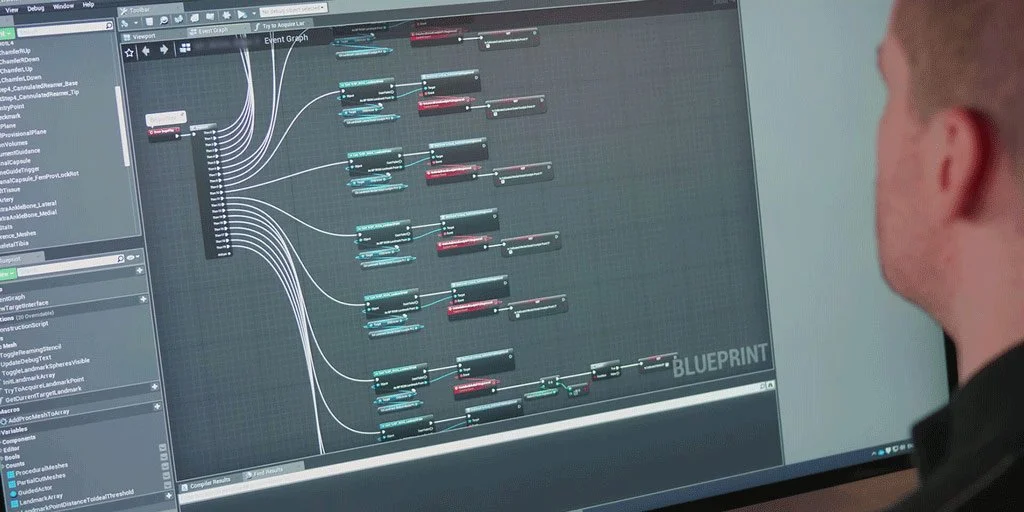A Deep Dive into the Power of Unreal Engine
As part of our series of getting to know some of the more interesting and forward-thinking figures in the defence space, and how they are utilising the best tech to achieve their goals, this month we spoke to Walt Yates, Simulation Solution Advisor for the Unreal Engine at Epic Games.
Walt's journey to the simulation space began almost 20 years ago as a student at the Naval Postgraduate School where the first iteration of Unreal Engine was being used as the development platform for the America's Army game series. This was a free first-person shooter and training tool that was incredibly popular at the time but was becoming increasingly expensive for the army to license.
In 2014, however, Epic made the engine open source and royalty-free for the simulation space, and that represented a major cost-saving opportunity of which Walt was a major proponent. Epic took notice and approached Walt (who was working as programme manager for the Marine Corps at the time) to work as a simulation solution advisor and represent Epic to the simulation community based in Orlando, Florida.
His role is essentially to be an advocate for Epic Games and Unreal Engine within the simulation and training community. He works to ensure developers know exactly what the engine is capable of, and his team works with those developers to help them meet their goals. Walt describes himself as a "matchmaker" between simulation companies and Epic and, given the power and ubiquity of Unreal Engine, he admits his job is rarely too difficult.
However, there are always going to be obstacles to adoption. Here, we'll be discussing a few of these obstacles as well as the new developments being made in the engine and the wider sector. We'll also be picking Walt's brain about some of the more exciting case studies and getting his personal opinion on what's next for Epic.
Why is Unreal Engine so popular?
According to Walt, a major facet of the engine's popularity within the simulation space can be attributed to its royalty-free status. "Historically speaking," he says, "about 90% of my programme budgets for game-based training were devoted to licensing the environment. That left very little for specific content that was focused on learning skills and assessing skills in specific scenarios."
He was already a strong proponent of Unreal Engine when he was approached by Epic to spread the word about what Unreal Engine 4 (and now 5) was capable of as a simulation platform. It's also, of course, an incredibly flexible and powerful platform that has been used to make some of the most popular video games of the last decade.
Who's using it right now?
Red Six AR is a company that recently moved part of their operations to the Orlando area and is making an extremely innovative in-flight, air-to-air combat training simulation environment built on Unreal Engine, purely in augmented reality.
Walt explains: "It's built on rendered elements from Unreal Engine placed inside the faceplate visor of the pilot of an aircraft. This way they can see their wingman and enemy aircraft and do drills in a safer, lower-cost environment than current alternatives where you actually have live aggressor squadrons flying against you."
There are also numerous governments and companies around the world using it to develop applications for their customers in global military organisations. SimCentric, for example, is based in London and develops applications for both the UK Ministry of Defence and for the Australian Defence Forces. And that's just the tip of the iceberg.
New horizons
There are hundreds of exciting new developments happening constantly within Unreal Engine and the simulation space. But the development Walt sees the most promise in is combining model-based systems engineering with games-based training.
He was recently asked to give a talk at the first annual Simulation Interoperability Standards Organisation symposium, where he discussed the idea of combining these two domains that have not traditionally used the same toolsets.
He says: "I spent most of my career in training simulations for human performance. But I got a three-year exposure to model-based systems engineering and came to understand that the tools they use rely on high-performance computing clusters, finite element analysis and simulations that don't necessarily run validated models in real time."
However, there's been a convergence in recent years thanks to increased computing power, cloud-hosted simulations and higher bandwidth networks. And this offers the possibility to put validated engineering models inside a game engine training scenario.
Walt expands on why this is so potentially game-changing: "Consider a tactical or a combat vehicle design that's being tested. You could place those validated models inside a game engine where those vehicles are being operated by hundreds of human participants and then gather data from them. This data can then be used in developmental testing and to design working prototypes."
He also waxes lyrical on the power of double-precision coordinate systems in Unreal Engine 5, which he feels will be truly relevant in serious simulations. This means that simulation teams using Unreal Engine 5 (which is still in Early Access as we speak) will have access to sub-millimetre precision in global navigation, putting the engine on par with a commercial flight simulation.
Challenges to adoption
There are always going to be on-ramps to adoption for any technology, even one as groundbreaking as Unreal Engine. Walt explains that one challenge is outdated perceptions of what a game engine can do. Many practitioners in the simulation industry are pleasantly surprised to find that what they believed to be limitations of game engines were actually broken through years ago.
The biggest challenge, however, is the sunk cost in existing content developed for legacy simulation platforms. But Walt assures us that it's fully possible to migrate existing approaches into an Unreal Engine simulation and have all of the fidelity with more options for plugins and features that would otherwise be very expensive to develop and maintain internally. And those savings pay off in spades due to Unreal Engine's future-proof infrastructure and state-of-the-art features.
He explains: "Companies that have traditionally had to use an internally developed image generator now have the image generator from Unreal Engine at their disposal. So, if a company's competitive edge is in their modelling and how they represent the entities, and in a given simulation environment, they can focus on what they do best. It's a conservation of resources and using your time as wisely as possible."
Ultimately, with Unreal Engine, you have an ecosystem of global developers that are potentially solution developers for your product. In turn, you benefit from having more competition in contracting, soliciting more broadly and avoiding the drawbacks of being hamstrung by a proprietary tool.
What's next for Epic Games?
Epic Games has aspirations to be the solution for real-time 3D across any and all applications. It's far beyond just simulation. You'll see the engine being used in everything from major Hollywood movies to broadcast TV and automotive applications. For example, it's capable of 3D storm simulations for The Weather Channel so the presenter can literally stand in the middle of a storm surge and visualise what it would look like, rendered in real time.
"Wherever there's an application for real-time 3D, Epic Games is ready to provide the tools for that," Walt says. "And it's not just Unreal Engine itself either. It's the tools and content libraries that have been acquired and the collaborations with different developers that make the plugins for Unreal Engine. That's what also provides the value."
He runs off a list of examples of companies Epic has acquired in recent years, including Quixel and their extensive Megascans library of cloud-based 3D content, and Capturing Reality, whose photogrammetry application allows you to "take a camera image from something as simple as your smartphone and construct a 3D mesh out of it that's usable in Unreal Engine or any other 3D modelling application."
Providing all of these tools makes development workflows more efficient and more convenient. And that's essentially what Epic Games is trying to do in areas as diverse as cinema and healthcare. The autonomous vehicle industry is also using Unreal Engine to train AI agents for navigation.
Going forward, meanwhile, a great deal of potential exists in the recently introduced MetaHuman avatars, which are realistic representations of humans, down to the individual hairs and facial expressions. Epic's MetaHuman Creator shrinks the time it takes to create a high-fidelity digital human from months to minutes - yet another example of how Epic is removing the barriers to harnessing the power of sophisticated 3D graphics technology.
The applications here are mind-blowing, as Walt explains: "It's got a tremendous amount of potential for role-playing games and virtual actors in movies but also for training physicians and military applications, too. In the healthcare domain, for example, it will be invaluable in essentially translating nonverbal interactions between patients and doctors. In military applications or law enforcement, meanwhile, when training interrogator translator teams on how to question a subject, the MetaHuman avatars could offer tremendous value."
It would appear as if the true potential of Unreal Engine and Walt's team have yet to be fully realised and that the sky really is the limit. Perhaps the most exciting thing, however, is that this technology is available to literally anyone with the time, the patience and the hardware to make the most of it. We can't wait to see what open-source wonders await us in the near future.
Interested in how Novatech could help with your defence simulation technology needs? Contact us today, or fill out the form below, and we'll find a bespoke solution for you.




